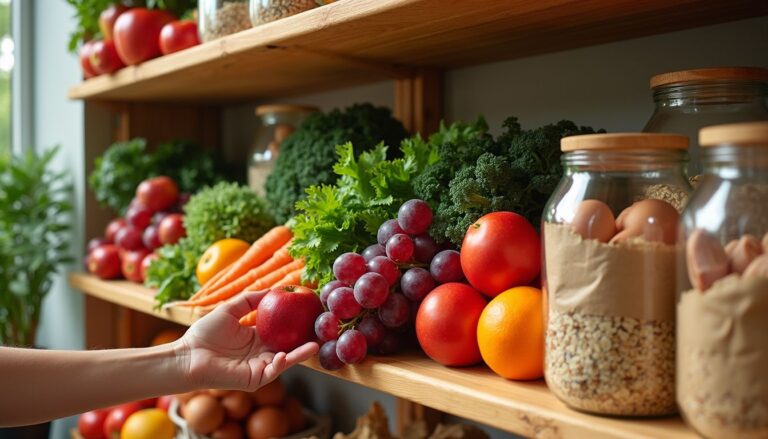The Ultimate Guide To Weight Loss Foods: Lose Weight With Calorie-Conscious Mediterranean And Mayo Clinic Diet Options
Our Nutrition Assistant AI Suite will transform your body. You will lose fat, get toned, and build muscle. Gain confidence and optimal health.
You may feel stuck if you want to lose weight but are unsure what to eat. Weight loss foods from the Mediterranean diet and the Mayo Clinic diet make healthy eating easier and more satisfying.
Research points to nutrient-dense choices like fruits, vegetables, lean protein, whole grains, and healthy fats. These foods help you manage calories, protect your heart, and support a healthy weight.
This guide shares practical, evidence-based steps. You will see how smart food choices can make meal planning simple and help you stay on track.
Key Takeaways
- The Mediterranean and Mayo Clinic diets spotlight nutrient-dense, low-calorie foods for steady, sustainable weight loss.
- Studies from 2016–2023 suggest these eating patterns help reduce excess body fat and lower risks linked to obesity and type 2 diabetes.
- The Mayo Clinic Diet uses a Healthy Weight Pyramid, emphasizing vegetables, mindful portions, and daily tracking for lasting results (Hensrud DD et al., 2020).
- High-fiber foods like beans, oats, fruit, and non-starchy vegetables help you feel full on fewer calories and support heart health.
- Evidence from NEJM shows that olive oil and other unsaturated fats can lower LDL, often called bad cholesterol, during weight management (Estruch R et al., 2013, 2018).

What is the connection between weight loss and nutrition?

Your daily food choices drive your weight loss results. A healthy diet helps you control calories, protect health, and build habits that last.
How do calorie-conscious diets aid weight loss?
Calorie-conscious diets let you eat more food for fewer calories. For example, a small fries is about 250 calories. The same calories could be 10 cups of spinach or roughly 1.5 cups of strawberries.
Low energy density foods, such as fruits and vegetables, are high in fiber and water. Larger portions satisfy hunger without a high calorie load. A 2007 study found that a broth or tomato-based soup before meals can lower intake and support a weight loss plan.
Simple swaps help. Choose grapes over raisins for about 104 calories per cup instead of about 480. One pat of butter has almost the same calories as two cups of raw broccoli, but broccoli brings fiber and vitamins.
These swaps align with advice from groups like the American Heart Association. They help manage carbohydrate intake, fat mass, and saturated fat.
Eating foods high in water and fiber helps you feel satisfied on fewer calories.
Why are nutrient-dense foods important for losing weight?
Nutrient-dense foods deliver vitamins, minerals, fiber, and protein with fewer calories. Good examples include fruits, vegetables, legumes, nuts, seeds, whole grains, and lean proteins.
Water-rich foods lower hunger. Watermelon has around 46 calories per cup and is about 92 percent water. Cucumber offers about 16 calories per cup and is roughly 95 percent water.
High-fiber foods, like beans and whole grains, slow digestion and help steady blood sugar. You stay full longer and snack less.
Choosing these foods over ultra-processed snacks high in sodium or added sugar supports the Dietary Guidelines for Americans. As you read about Mediterranean Diet basics next, watch for easy ways these foods fit into your routine.
Mediterranean Diet Basics and Benefits
This diet focuses on simple, whole foods. It can support weight loss and keep your energy steady through the day.
What is the Mediterranean Diet?
The Mediterranean diet centers on fruits, vegetables, whole grains, legumes, nuts, seeds, and olive oil. Olive oil is the main added fat, replacing butter or margarine at meals.
Fish and seafood show up at least twice a week for omega-3 fatty acids. These are healthy fats that support your heart.
Ultra-processed foods and unhealthy fats, like trans fat and excess saturated fat, are limited. Red meat and sweets become occasional treats.
If you drink alcohol, moderate wine intake is optional for adults. This approach supports weight loss because the foods are filling yet naturally lower in calories.
Small shifts, done daily, can change how you feel and eat.
What are the key principles and food pyramid of the Mediterranean Diet?
The food pyramid starts with vegetables, fruits, whole grains, beans, nuts, and seeds. These are the base of most meals.
Olive oil is the main fat source. Meals are rich in healthy unsaturated fats and lower in saturated fat. Fish and seafood appear a few times per week.
Lean poultry, eggs, cheese, and yogurt come in smaller amounts. Red meat and sweets sit at the top of the pyramid for occasional use.
Movement matters too. Gentle activity or strength training pairs well with this diet and supports steady weight loss. Sharing meals with others can improve satisfaction and helps habits stick.
How does the Mediterranean Diet help with weight loss?
Fiber from whole grains, legumes, and leafy greens helps you feel full on fewer calories. Healthy fats from olive oil and nuts add satiety, which curbs grazing later.
Protein from fish and lean meats supports muscle while you lose fat. Studies from 2016 to 2023 link this pattern with lower risks of obesity, diabetes, and other metabolic issues.
I noticed steady progress using this approach. Planning grilled chicken with roasted vegetables kept me full without cravings.
Mayo Clinic Diet Fundamentals
The Mayo Clinic Diet guides you to eat low-calorie, low-fat foods, build healthy habits, and move your body.
What is the Mayo Clinic Diet?
This plan uses the Healthy Weight Pyramid. Vegetables fill the base, so they anchor your plate. Choose low-calorie, high-volume picks like salad greens, asparagus, carrots, tomatoes, broccoli, and zucchini.
Whole fruits beat juice or dried fruit since they are less calorie dense and higher in fiber. Select whole grains like whole-wheat bread, oatmeal, brown rice, or whole-grain cereal for steady energy.
Lean proteins include beans, lentils, fish such as salmon or tilapia, skinless poultry like chicken breast, and egg whites. Add small amounts of healthy fats from nuts, seeds, and olive oil.
Swapping sugary snacks for water-rich fruit can help control appetite between meals.
How does the Mayo Clinic Diet focus on lifestyle and calorie tracking?
This plan encourages you to track food intake and portion sizes. Replacing high-calorie snacks with raw vegetables adds volume without many calories.
Boost veggie portions by topping pasta with sautéed vegetables or adding leafy greens on the side. Limit sweets to small servings made with nutrient-rich ingredients such as fruit or low-fat dairy like Greek yogurt.
Water and fiber-rich foods, such as oranges and beans, reduce energy density. You eat fewer calories and still feel satisfied.
Tracking daily choices builds awareness and routine. A simple food log can reveal patterns within a week.
How does the Mayo Clinic Diet support sustainable weight loss?
This approach favors gradual changes that last. Choose foods that are low in calories and high in volume, for example water-rich fruits and vegetables.
These foods help reduce body fat over time. Focus on portions and the type of food at each meal. Include lean protein like chicken breast or eggs to support muscle and fullness.
Small treats are allowed in moderation, which helps adherence. Pair healthy eating with regular activity for better results, as summarized in a systematic review and meta-analysis.^1
Guidelines are updated as new evidence emerges, so the plan fits real life.
Which foods are best for weight loss?
Picking the right foods makes it easier to stay on track. The options below are filling, rich in nutrients, and fit a low-calorie diet.
Why are eggs good for weight loss?
Eggs are nutrient dense and satisfying. One large egg has about 6 grams of protein, and the white offers roughly 3.6 grams.
Protein and fat help you feel full after breakfast. A 2020 study found people who had eggs with toast felt fuller than those who ate cereal, milk, and juice.
Pair eggs with fiber-rich foods, like vegetables or whole-grain toast, for extra satiety. I found that scrambled eggs in the morning cut my pre-lunch snacking.
How do leafy greens contribute to weight loss?
Leafy greens such as kale, spinach, and collards pack fiber and vitamins with very few calories. You can fill half your plate without overdoing calories.
These greens are high in water, which boosts fullness. Thylakoids, plant membranes in leaves, may help manage appetite in early research.
Dietitians often add greens to plant-forward meal plans because they are satisfying and nutrient dense.
What weight loss benefits do fish and shellfish offer?
Fish and shellfish provide high-quality protein for fewer calories. A 5-ounce serving of white fish gives about 25 grams of protein, which helps control hunger.
Seafood supplies omega-3 fats and iodine. Omega-3s support heart health. Iodine helps your thyroid, which regulates metabolism.
Baked salmon or sautéed shrimp in olive oil fits both the Mediterranean and Mayo Clinic approaches.
How do cruciferous vegetables aid in losing weight?
Broccoli, cauliflower, and cabbage are high in fiber and low in calories. They add bulk to meals and keep you satisfied longer.
These vegetables also bring vitamin C and other nutrients. Try roasted broccoli or a vegetable stir-fry to add flavor and variety without many calories.
Why choose lean meats like chicken breast for weight loss?
Skinless chicken breast is high in protein and lower in saturated fat than many meats. A 3.5-ounce serving has about 25 grams of protein.
Lean cuts supply iron, which supports energy. Bake, roast, grill, or sauté to keep calories modest. Pair with vegetables or whole grains for balance.
Are potatoes and root vegetables good for weight loss?
Yes, if you prepare them wisely. Boiled white potatoes score high on the Satiety Index, which means they can help with appetite control.
Cooling boiled potatoes increases resistant starch, a type of carb that acts like fiber. It feeds healthy gut bacteria and may improve fullness.
Bake or roast instead of frying to limit added fat. Carrots and turnips also add fiber, potassium, and vitamin C.
How do beans and legumes support weight loss?
Lentils, black beans, chickpeas, and kidney beans are rich in protein and fiber. One cup of cooked lentils has about 18 grams of protein and 15 grams of fiber.
These nutrients slow digestion and steady blood sugar, which reduces hunger. Resistant starch in beans can add to this effect.
Adding beans to salads, soups, or whole-grain toast boosts fullness without many calories. People who eat legumes often have healthier body weights over time.
Why include whole grains in a weight loss diet?
Whole grains like oats, brown rice, and quinoa provide more fiber and protein than refined grains. This supports longer-lasting fullness and steady energy.
A 2022 study of 460 adults with type 2 diabetes found that high-fiber diets, including whole grains, may help reduce body fat.
Swapping white toast for oatmeal helped me manage hunger through busy mornings. Whole grains also add key vitamins and minerals.
What role does cottage cheese play in weight loss?
Cottage cheese is a low-calorie, high-protein dairy option. One cup offers about 24 grams of protein for around 200 calories.
It supports muscle while you cut calories. Calcium supports bone health and may play a role in fat metabolism.
Top cottage cheese with fruit for a quick snack. It is simple, filling, and nutrient dense.
How do avocados fit into a weight loss plan?
Avocados provide heart-healthy fats and fiber. Half an avocado has about 120 calories, so portion control matters.
The mix of fat and fiber promotes fullness. You also get potassium and other nutrients that support heart and muscle function.
Use sliced avocado on salads or toast in place of creamy spreads to keep calories in check.
What benefits do nuts and seeds provide for weight loss?
Nuts and seeds are satisfying in small portions. Almonds, walnuts, chia, and sunflower seeds offer unsaturated fat, protein, and fiber.
Studies suggest about 1 ounce per day can fit a calorie-conscious plan. In a small 2017 study, chia added to yogurt increased fullness and reduced intake at lunch.
I like Greek yogurt with chia and flax. It keeps me full longer than many snacks.
Why is Greek yogurt recommended for weight loss?
Greek yogurt is higher in protein than regular yogurt, often about 10 grams per 3.5 ounces. More protein helps with satiety and cuts cravings.
Probiotics support gut health. Some studies link full-fat varieties with lower risks of obesity and type 2 diabetes. Pair Greek yogurt with fruit for a balanced snack.
Key Foods in the Mediterranean Diet
This eating pattern leans on foods that are satisfying, flavorful, and friendly to your calorie goals.
Olive oil and healthy fats
Olive oil is the main added fat. It provides unsaturated fats that can lower LDL cholesterol and support heart health.
One tablespoon has about 120 calories, so measure portions. Small amounts help you absorb vitamins A, D, E, and K from produce.
Adding a teaspoon or two to salads made me less hungry between meals. Research supports moderate unsaturated fat intake during weight loss (Estruch et al., NEJM 2018).
Fresh fruits and vegetables
Fruits and vegetables sit at the base of the Mediterranean pyramid. Options like blueberries, peaches, apples, grapes, and oranges are rich in fiber and water.
Most fresh fruit contains roughly 40 to 60 calories per serving and provides vitamins like vitamin C and potassium. You can eat large portions without a big calorie load.
Starting meals with a salad or fruit helped me pass on less healthy snacks later. More servings can reduce daily calories and improve hydration.
Whole grains and legumes
Oats, brown rice, and quinoa deliver fiber and steady energy. Beans, lentils, and chickpeas add protein, minerals, and resistant starch.
People who eat more whole grains often have lower body weights. I rely on black bean bowls and quinoa salads because they are quick, tasty, and keep me full.
Fish and seafood
Fish and seafood offer protein, omega-3 fats, and iodine. Aim for two or more servings per week.
Choosing salmon or shrimp instead of ultra-processed meats keeps calories reasonable while delivering key nutrients.
Key Foods in the Mayo Clinic Diet
The Mayo Clinic Diet highlights foods that add volume, support digestion, and help you control calories with less effort.
Low-calorie, high-fiber options
Vegetables like greens, asparagus, carrots, tomatoes, broccoli, and zucchini are fiber rich and low in calories. They fill your plate and help you stay full.
Whole fruit beats juice or dried fruit because it is less calorie dense. Watermelon has about 46 calories per cup and is about 92 percent water. Cantaloupe is around 60 calories per cup with about 90 percent water. An orange has about 45 calories.
Oatmeal and whole-grain cereal bring fiber and volume that tame hunger. Nuts can help too if you keep portions small.
Lean protein sources
After boosting fiber, add lean protein to meals. Fish, skinless chicken breast, and other lean meats offer high-quality protein with less saturated fat.
Beans, peas, lentils, and firm tofu provide protein with fewer calories. Egg whites and low-fat or fat-free dairy also help you meet protein goals.
These foods improve fullness and fit calorie limits used in the Mediterranean and Mayo Clinic plans.
Water-rich fruits and vegetables
Cucumbers are about 95 percent water and only around 16 calories per cup. Raw vegetables make an easy swap for chips or sweets.
Larger portions of water-rich produce support fullness and help you meet calorie goals. Sliced cucumbers or bell peppers often leave you satisfied without feeling weighed down.
What are the benefits of calorie-conscious diets?
These diets focus on food quality and portions. They help you build habits that stick and support health over time.
How do calorie-conscious diets help you feel full with fewer calories?
Water and fiber add volume to meals without adding many calories. You can eat more food by weight while taking in fewer calories.
Broth-based soups and large salads before dinner can lower total intake. Studies show low-calorie, high-volume foods satisfy hunger better than calorie-dense snacks of the same calories.
Both the Mediterranean and Mayo Clinic diets lean on these filling foods to control appetite.
How do these diets support long-term weight management?
They help you feel full on fewer calories, which makes maintenance easier. You focus on whole foods, fiber-rich vegetables, and lean proteins.
Swapping to water-rich fruit and tracking intake builds awareness that prevents overeating. Allowing small treats in moderation improves satisfaction.
A 2013 study found that gradual changes improved the odds of keeping weight off at one year. I felt more confident once I focused on small, steady steps.
How do calorie-conscious diets promote overall health and well-being?
Calorie-conscious meals, filled with fruits, vegetables, whole grains, and lean proteins, give your body the nutrients it needs. This pattern supports heart health and may lower the risk of chronic disease.
People often notice better digestion, more stable energy, and improved lab numbers after making these changes. Capsaicin in spicy dishes may also support metabolism.
Seek help from a registered dietitian or your clinician if you have medical conditions, take medications, or need a personalized plan.
How can you create a balanced meal plan?
You can blend both diets to build a plan that fits real life. Keep it simple, practical, and repeatable.
How to combine Mediterranean and Mayo Clinic diet principles?
- Choose minimally processed foods, for example vegetables, fruits, whole grains, fish, beans, and lean proteins most of the time.
- Use olive oil or nuts as your main fats instead of butter or margarine.
- Eat a rainbow of produce daily. Aim for five or more servings to boost fiber and vitamins.
- Include fish or shellfish two to three times per week to support heart health.
- Fill half your plate with non-starchy vegetables to lower calories and increase fullness.
- Limit ultra-processed snacks and sweets. Favor home-prepared meals.
- Add beans and legumes several times per week for plant protein and fiber.
- Track portions with measuring tools or visual cues to manage calories without strict counting.
- Snack on water-rich foods like melon or cucumber to stay full and hydrated.
- Plan meals ahead. Mix Mediterranean recipes with Mayo Clinic style dishes for variety.
These steps create a balanced pattern that supports sustainable weight management.
What are effective ways to track portion sizes and calorie intake?
- Use a digital kitchen scale for proteins and grains to match serving sizes.
- Measure liquids and solids with cups and spoons. This is helpful for oils and nut butters.
- Log meals in a calorie-tracking app such as MyFitnessPal or Lose It! to estimate daily intake.
- Use visual cues. A fist equals about one cup of vegetables. A deck of cards equals roughly three ounces of chicken.
- Pick whole fruit instead of juice or dried fruit to lower energy density and add fiber.
- Swap high-calorie snacks for raw vegetables or fruit to stay within goals.
- Follow the Healthy Weight Pyramid: half plate vegetables, one quarter lean protein, one quarter whole grains.
- Keep sweets small and occasional. Log them so added sugars do not creep up.
- Read labels to check calories per serving before you eat packaged foods.
Switching from juice to whole oranges made it easier for me to meet my calorie target.
How to stay consistent with healthy eating habits?
- Make gradual changes. Add one vegetable to each meal to build momentum.
- Plan meals and snacks to reduce last-minute, high-calorie choices.
- Increase vegetable portions at breakfast, lunch, and dinner to support fullness.
- Keep ready-to-eat vegetables on hand, like carrot sticks and sliced peppers.
- Track what you eat daily to spot patterns that need adjustment.
- Use portion tools such as smaller plates and measuring cups to prevent overeating.
- Work with a registered dietitian if you want expert support.
- Set clear, simple goals, for example five produce servings each day.
- Keep water nearby. Thirst can feel like hunger and lead to extra snacking.
- Review your progress each week to stay motivated.
Adding more vegetables each week made it easier for me to stick with both diet styles.
Conclusion
Choosing calorie-conscious foods sets you up for long-term success. The Mediterranean diet and the Mayo Clinic diet offer research-backed ways to eat well, feel full, and control calories without feeling deprived.
Eggs, leafy greens, lean meats, fish, beans, whole grains, nuts, avocados, and Greek yogurt are all foods that may help you lose weight. These nutrient-dense options support a healthy weight and improve well-being.
Consistency, planning, and small changes add up over time, as clinical research suggests.[^1][^2] Talk with your healthcare provider before making major diet changes, especially if you have a medical condition or take prescription medicine.
Healthy weight management gets easier when your meals are satisfying, simple, and built from whole foods.
[^1]: Estruch R et al., Primary Prevention of Cardiovascular Disease with a Mediterranean Diet, New England Journal of Medicine (2013).
[^2]: Hensrud DD et al., The Mayo Clinic Diet, Mayo Foundation for Medical Education and Research (2020).
FAQs
1. What are the main foods recommended in calorie-conscious Mediterranean and Mayo Clinic diet plans?
Both diets highlight vegetables, fruits, whole grains, beans, nuts, seeds, lean poultry, and fish. The Mediterranean plan uses olive oil as a primary fat source while the Mayo Clinic approach encourages low-calorie density choices such as leafy greens and berries.
2. How do these diets help with weight loss according to research?
Studies show that eating more plant-based foods with fewer processed items lowers total calorie intake. For example, a 2020 review found people following a Mediterranean-style pattern lost an average of 8 to 10 pounds over twelve months compared to standard Western eating habits (Estruch et al., New England Journal of Medicine).
3. Are there specific nutritional benefits linked to these food choices?
Yes; both approaches provide high fiber content which supports fullness and digestive health. They also offer healthy fats from sources like olive oil or nuts that may reduce heart disease risk while maintaining steady energy levels throughout the day.
4. Can you share a personal experience using either diet for weight management?
After switching my lunch routine from sandwiches on white bread to salads topped with chickpeas and grilled chicken breast plus extra-virgin olive oil dressing I noticed improved satiety until dinner time along with gradual weight reduction over several weeks.
Summary: Both dietary patterns focus on nutrient-rich options that support sustainable weight control through evidence-backed strategies including increased fiber intake lower calorie density meals and healthier fat sources.







